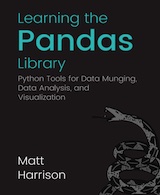
|
FreeComputerBooks.com
Links to Free Computer, Mathematics, Technical Books all over the World
|
|
- Title: Learning the Pandas Library: Python Tools for Data Munging, Analysis, and Visualization
- Author(s) Matt Harrison
- Publisher: CreateSpace (June 1, 2016); eBook (Online Edition/Final Draft)
- Paperback: 222 pages
- eBook: PDF (208 pages)
- Language: English
- ISBN-10: 153359824X
- ISBN-13: 978-1533598240
- Share This:

|
This book is designed to bring developers and aspiring data scientists who are anxious to learn Pandas up to speed quickly. It starts with the fundamentals of the data structures. Then, it covers the essential functionality. It includes many examples, graphics, code samples, and plots from real world examples.
About the Authors- Matt Harrison runs MetaSnake, a Python and Data Science consultancy and corporate training shop. In the past, he has worked across the domains of search, build management and testing, business intelligence, and storage.

- Learning the Pandas Library: Python Tools for Data Munging, Analysis, and Visualization
- The Mirror Site (1) - PDF
- The Mirror Site (2) - PDF
- Video Lecture (YouTube) by Matt Harrison
-
 Python Matplotlib Basics (Sandro Tosi)
Python Matplotlib Basics (Sandro Tosi)
This is a practical, hands-on book, with a lot of code and images. It presents the real code that generates every image and describes almost every single line of it, so that you know exactly what's going on.
-
 Python for Data Analysis: Pandas, NumPy, and Jupyter
Python for Data Analysis: Pandas, NumPy, and Jupyter
The focus is specifically on Python programming, libraries, and tools as opposed to data analysis methodology. This is the Python programming you need for data analysis. You'll learn the latest versions of pandas, NumPy, and Jupyter in the process.
-
 Data Analysis with Python (Numpy, Matplotlib and Pandas)
Data Analysis with Python (Numpy, Matplotlib and Pandas)
Understand data analysis pipelines using machine learning algorithms and techniques with this practical guide, using Python. Equipped with the skills to prepare data for analysis and create meaningful data visualizations for forecasting values from data.
-
 O'Reilly® Python Data Science Handbook: Essential Tools
O'Reilly® Python Data Science Handbook: Essential Tools
Several resources exist for individual pieces of this data science stack, but only with the Python Data Science Handbook do you get them all - IPython, NumPy, Pandas, Matplotlib, Scikit-Learn, and other related tools.
-
 From Python to NumPy (Nicolas P. Rougier)
From Python to NumPy (Nicolas P. Rougier)
NumPy is one of the most important scientific computing libraries available for Python. This book teaches you how to achieve expert level competency to perform complex operations, with in-depth coverage of advanced concepts.
-
 Guide to NumPy (Travis E. Oliphant)
Guide to NumPy (Travis E. Oliphant)
This book is for programmers, scientists, or engineers, who have basic Python knowledge and would like to be able to do numerical computations with Python. It will give you a solid foundation in NumPy arrays and universal functions.
-
 NumPy Tutorials (Usman Malik, Anne Bonner, et al)
NumPy Tutorials (Usman Malik, Anne Bonner, et al)
They provide everything you need to know to get started with NumPy. They also explain the basics of NumPy such as its architecture and environment, discusses the various array functions, types of indexing, etc. With examples for better understanding.
-
 Scipy Lecture Notes (Emmanuelle Gouillart, et al)
Scipy Lecture Notes (Emmanuelle Gouillart, et al)
This book is the teaching material on the scientific Python ecosystem, a quick introduction to central tools and techniques. It is for programmers from beginner to expert. Work on real-world problems with SciPy, NumPy, Pandas, scikit-image, and other Python libraries.
-
 SciPy Programming Succinctly (James McCaffrey)
SciPy Programming Succinctly (James McCaffrey)
This book offers readers a quick, thorough grounding in knowledge of the Python open source extension SciPy. The SciPy library, accompanied by its interdependent NumPy, offers Python programmers advanced functions that work with arrays and matrices.





